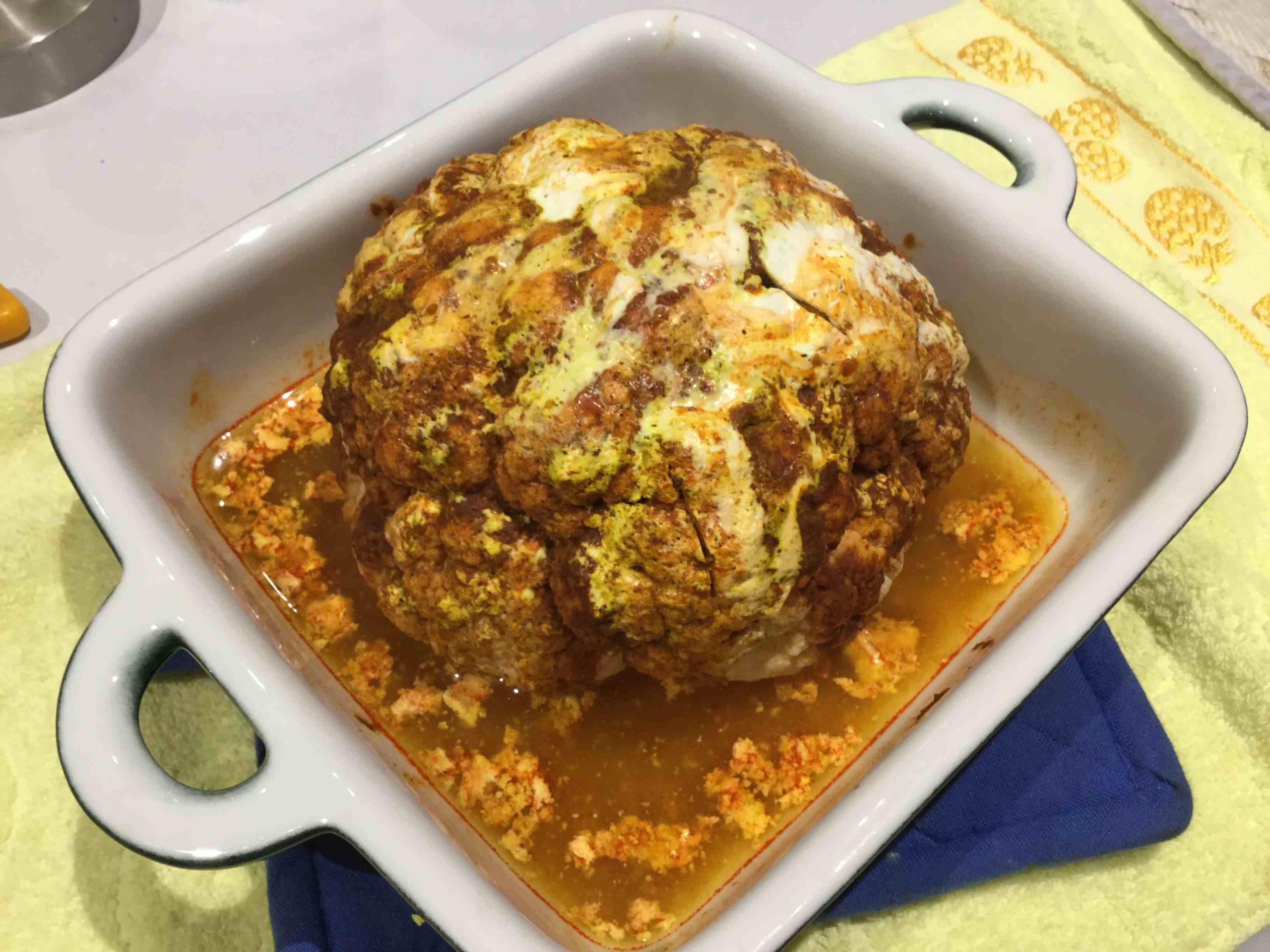We experiment often, trying new methods or recipes or trying to recreate something we have eaten somewhere or other. There are successes and failures, there is elation and disappointment. Whole cauliflower is something we have tackled a few times. (Note: See the June 2019 and February 2020 updates at the end of this post.)
Baked Whole Cauliflower
In our first attempt at cooking whole cauliflower, some time ago, we placed the head in a large pudding bowl, then we poured over some cream, added some seasoning and topped it with some grated tasty cheese. We microwaved it slowly, covered. The reason for microwaving is that a pudding bowl holds the cauliflower head quite nicely and, as well, it is possible to cook it gently by using low power while it cooks throughout. Covering provides a steaming effect and it is easy to add more cooking time if required, aiming for a cauliflower that is soft and tender. Other times we would leave off the cheese, but sprinkle it over the cauliflower at the end, then grill it. We would serve it in the pudding bowl as a vegetable accompaniment! We would say the result – cauliflower in a cheesy, creamy sauce – was good, rather than sensational.
We tried Neil Perry’s method for baked cauliflower a year or so ago when this recipe was published in The Age: Whole roasted cauliflower with lemon and mustard.
In brief, the recipe involves:
- Cutting away the base of the stalk so the cauliflower can sit flat, then cutting a cross in the base.
- Drizzling with some olive oil and sprinkling with some salt.
- Baking until tender, piercing the cauliflower with a knife until it goes through easily.
We are happy to take the blame, but it didn’t work for us, mainly because the cauliflower was well and truly crisped before the inside was even faintly tender. And the dressing did not go well with cauliflower al-dente! We certainly needed something somewhat more substantial than a butter knife to cut it; more like a bread knife. We haven’t revisited that recipe.
Then we read about Eyal Shani’s Cauliflower. International chef, Eyal Shani, recently opened a restaurant in Melbourne, called Miznon. The author of the article, Dani Valent, writes: “the emblematic dish at Miznon is a whole cauliflower: blanched, ‘moisturised’ with olive oil, roasted to golden brown and served whole.”
It seems they cook 13,000 a month in the restaurant in Israel!
According to Valent, producing one of these cooked whole cauliflowers could not be simpler: “Boil it in salted water ’til it is medium soft. Set it aside to steam dry. Moisturise it with olive oil with your hands. Sprinkle it with salt. Bake it in a very hot oven, around 220oC or hotter, until it’s golden brown. That’s all.”
We wanted a tad more guidance and found this link: How to Make Eyal Shani’s Famous Cauliflower.
There we found more instructions, which you can read for yourself. The article says: “We show you how to make the original whole roasted cauliflower, using the celebrity chef’s own instructions.” The written instructions are quite clear.
However, again we lucked out. We think we followed the instructions closely but were possibly too cautious at the boiling stage, trying not to over-cook it. The end result was similar to our Neil Perry attempt: a crisp exterior that couldn’t really be cooked any further, but a rather undercooked interior. It certainly was not the gourmet sensation that we were hoping for, and really called for an accompanying sauce of some description. Two photos of our attempt follow.
Clearly we need to try again.
PS It was our idea, at the last minute, to add some Brussels sprouts we had on hand. We steamed them and baked them alongside the cauliflower. They were actually really soft and delicious.
Update: June 2019
Richard Cornish, writing for the Melbourne Age, provided this advice: How to cook the perfect whole cauliflower.
In order to avoid an over-cooked exterior and an under-cooked interior, you will see he writes:
“The trick is to increase the humidity. Try placing your cauliflower in a large ovenproof dish – enamel-coated steel is perfect for this. Drizzle with a little extra virgin olive oil, sprinkle with a little salt, cover with the lid and place into the over at 200C (180C fan-forced) and cook for 45 minutes to an hour or until done. The water in the cauliflower will evaporate and create a hot and humid environment, stopping the florets from drying while radiant heat will still give the cauli a brown finish. Remove the lid at the 40-minute mark if you like a little crunch.”
Update: February 2020
With our new steam oven we are able to steam large dishes, dishes that might not fit in a standard over-the-stove steamer, or even an electric one.
We tried steaming a whole cauliflower with curry paste and yogurt. In brief, it involved:
- Cutting away the base of the stalk so the cauliflower could sit flat, then cutting a cross in the base to help it cook through.
- Smearing with an Indian curry paste, then drizzling yogurt over the top of that.
- Steaming for 40 minutes, towards the end piercing the cauliflower with a knife until it entered easily.
We would describe this result as good, rather than sensational. Next time, perhaps we will steam the cauliflower head first to soften it more, then complete the steaming with the curry paste and yogurt. It is easy to serve and carve at the table.
Contributions welcomed!
If you have been trying to perfect a recipe, we are happy to hear about your attempts, including the recipe, problems and successes (and good quality photos if you have any).






